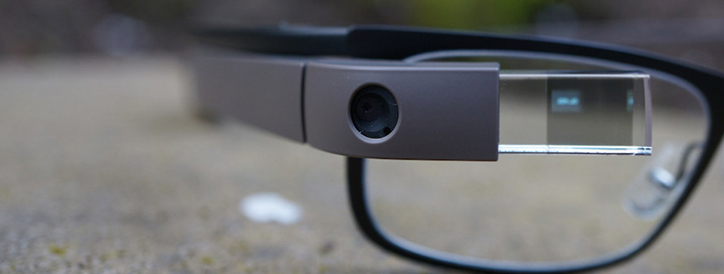When the beta version of Google Glass was released for purchase to “Glass Explorers”, it generated much excitement. However, some glaring issues in the design led to the Glass being a handful to use. Not to mention an overall lack of utility, which also emerged from the clunky looks and feel of the Glass, which made it a novelty as opposed to a piece of tech that would be adopted by the masses. So, it could never reach mass production and mass adoption. But, Google has been working on the design aspect and has come up with some major improvements up its sleeve.
In two recently published patents, Google has disclosed a “see-through curved eyepiece with patterned optical combiner” and a “bone conduction transducer with a magnet anvil”. The first patent talks about a wearable head mounted display. The curved eyepiece will include a display panel, two lens bodies, combined by an optical combiner, the first of which includes a light guide. The curved eyepiece will receive display light generated by a display panel through an input surface and will emit display light in an eye-ward direction in the viewing region towards a user’s eye. The display light is guided through the light guide by total internal reflection between the input surface and optical combiner. The curved eyepiece will be thin, with a possible thickness of around 4 mm. The thickness may be reduced by the use of transparent optical grade plastic with a high refractive index, which also leads to a higher viewing area. Also, the curved eyepiece may be manufactured to provide prescriptive lensing to ambient light. What this means is, that the curved eyepiece may also be used by people requiring spectacles.
The second patent talks about a bone conduction transducer (BCT) to provide audio in wearable devices. The BCT has a yoke made of a pair of arms located at two ends of the yoke. The BCT also has a metallic post located between the pair of arms made from high permeability steel. The metallic post extends within a metal coil. Even further, the BCT includes two springs with a diaphragm at one end. The diaphragm will vibrate based on a signal received from the metal coil. The vibrations may vibrate the wearer’s bone structure at a location where the vibrations will travel through the wearer’s bone structure to the middle or inner ear, such that the brain interprets the vibrations as sounds. The BCT will be made of a permanent magnetic material to conduct rich and distinct sounds even at higher volumes. The patent discloses Google’s intention to implement this tech “in a wearable computer having a head-mounted display (HMD) or any type of device having a glasses-like form factor. Further, an example embodiment involves an ear-piece with a bone-conduction speaker (e.g., a vibration transducer)”.
Publication Number: US20180252923A1
Patent Title: See-through curved eyepiece with patterned optical combiner
Publication date: 2018-09-06
Filing date: 2018-09-06
Inventors: Ozan Cakmakci, James C. Dunphy, Oscar A. Martinez
Original Assignee: Google LLC
US20180252923A1
Publication Number: US20180255401A1
Patent Title: Bone Conduction Transducer with a magnet anvil
Publication date: 2018-09-06
Filing date: 2017-03-02
Inventors: Michael Asfaw, Stephen Thompson, Chad SEGUIN
Original Assignee: Penn State Research FoundationGoogle LLC Priority date
US20180255401A1



